

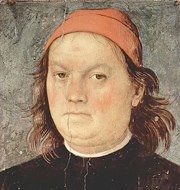
Self portrait (ca. 1500) from the Collegio di Cambio, Perugia
Pietro Vannucci, il Perugino was actually (despite his nickname) born in Città della Pieve. He almost certainly trained in Florence under Andrea del Verrocchio. He is first documented in Perugia in 1475, when he was paid for what must have been a minor commission in the Palazzo dei Priori. Yet, he emerges as a fully mature artist by 1479, when Pope Sixtus IV commissioned frescoes from him for the Cappella della Concezione of old St Peter’s, Rome (destroyed in 1602). He went on to work in the Sistine Chapel (see below) in ca. 1481-2.
Perugino maintained a workshop in Florence from at least 1487 until 1511. He also maintained a workshop in Perugia, probably from ca. 1495: his ownership of a workshop in Piazza del Sopramuro (now Piazza Matteotti) is documented in 1502-9.
Perugino’s most important commissions in Perugia (all described below) included:
-
✴the Decemviri Altarpiece (1495-6) in Palazzo dei Priori;
-
✴the San Pietro Polyptych (1495-1500);
-
✴the frescoes (1496-1500) of the Collegio del Cambio; and
-
✴the altarpiece (1499-1503) of the Marriage of the Virgin in the Cappella del Santo Anello of the Duomo.
Perugino failed to keep up with the rapid development of artistic taste from ca. 1500, and his reputation in Florence suffered badly when his Polittico dell' Annunziata (1504-7) for SS Annunziata there was badly received. He nevertheless continued to dominate the art scene in Perugia for some twenty years.
Associates of Perugino
Giorgio Vasari describes Pintoricchio as a disciple of Perugino, but the two artists were close in age and scholars suggest that they were associates rather than master and pupil. He says that they worked together in Rome at the time of Pope Sixtus IV (1471-84). This collaboration probably began in the late 1470s:
-
✴As noted above, Sixtus IV commissioned frescoes from Perugino for the Cappella della Concezione of old St Peter’s in 1479.
-
✴The work commissioned by Cardinal Domenico della Rovere for his chapel in Santa Maria del Popolo, which is generally attributed to Pintoricchio, seems to have been executed at some time between 1478 and 1482. It includes an altarpiece of the Adoration of the Magi that is closely related to the altarpiece (ca. 1470) from Santa Maria dei Servi,Perugia, which is attributed to Perugino (see below).
Pintoricchio might well have collaborated in Perugino’s frescoes ca. 1481-2 in the Sistine Chapel (see below).
Giovanni di Pietro, lo Spagna was documented in Perugino’s Florentine workshop in 1492, and it is likely that Giannicola di Paolo was associated with this workshop before 1493
According to Giorgio Vasari, Andrea d’ Assisi, l' Ingegno was the most promising of Perugino’s’s assistants in the Sistine Chapel of the Vatican Palace. Vasari also cited Andrea’s collaboration with Perugino in relation to the frescoes of the Collegio di Cambio in Perugia and at the Portiuncula in Assisi (see below).
The early works of Raphael owe much to Perugino: Giorgio Vasari commented that, had Raphael not signed what is now called the Mond Crucifixion (1502-3) in San Domenico, Città di Castello, it would have been attributed to Perugino. In 1521-4, the aged Perugino completed Raphael’s unfinished fresco (ca. 1505) in San Severo (see below), and this serves as a sad reminder of the extent to which his style had been overtaken.
An important document dated 1496 records that a group of artists formed a joint workshop in Perugia and took a year's lease on a workshop near the Porta Eburnea. These artist, some of whom had previously been associated with Perugino, were:
-
✴Eusebio da San Giorgio, who witnessed the contract (1495) commissioning Perugino to paint the San Pietro Altarpiece (below);
-
✴Berto di Giovanni, who collected a payment on behalf of Perugino in 1494 for the panel of the Pietà that was part of the Decemviri Altarpiece;
-
✴Ludovico di Angelo, who witnessed the final payment to Perugino for the San Pietro Polyptych in 1500; and
-
✴Lattanzio di Giovanni (died 1534), who had previously worked for Bartolomeo Caporali.
It is not known how long the formal association between these artists lasted, by they frequently worked together during the rest of their careers. They do not have seemed to have worked again with Perugino after 1495.
Galleria Nazionale, Perugia
Adoration of the Magi (ca. 1470)
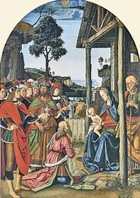
The attribution to Perugino is not universally accepted, but it is nevertheless supported by the fact that the face of the young man on the extreme left, who wears a red cap and looks at the viewer, seems to be a self-portrait. Dating to the early 1470s is supported by the fact that the face of the king with the green cloak was re-used for St Roch in a fresco (1476 or perhaps 1478) that is dated by inscription and also attributed to Perugino, which came from San Francesco, Deruta. It therefore seems likely that this was among Perugino’s earliest important commissions in Perugia.
The Madonna and Child are depicted at the entrance to the stable with the aged St Joseph to the right. The baby Jesus blesses the oldest of the three kings, who kneels before Him, while the other two kings and their courtiers stand to the left. All of the male faces seem to be portraits, probably of members of the noble family that commissioned the work (possibly the Baglioni) and their associates. The scene is set in a rocky landscape.
Gonfalon (1470s)
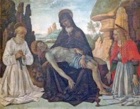
Miracles of St Bernardino of Siena (1473)
Many scholars believe that Perugino belonged to the so-called Workshop of 1473, which produced the important panels depicting miracles of St Bernardino of Siena that are now in the Galleria Nazionale. (Follow the links in the page on the Workshop of 1473 for more details).
Decemviri Altarpiece (1495-6)
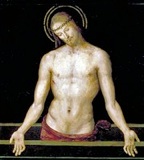
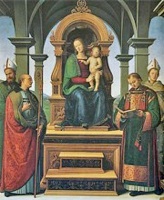
Upper panel Main panel
In situ Pinacoteca Vaticana, Rome
Replaced in the chapel by a copy
The Decemviri (ten magistrates) originally commissioned an altarpiece for their chapel in the Palazzo dei Priori (now part of the Galleria Nazionale) in 1479 from Pietro di Galeotto. The main panel was to depict the Madonna and Child with SS Laurence, Louis of Toulouse, Herculanus and Constantius, while the smaller upper panel could be of a subject of his choice. Although the contract stipulated that a steep penalty would arise unless the work was delivered within two years, it remained incomplete at the time of Pietro’s death in 1483.
In 1484, the commission passed to Perugino, who was to complete the main panel within four months and to paint the upper panel within a year. The subject of the latter was to be the Madonna della Misericordia with portraits of the Decemviri, who would presumably be depicted sheltering under her cloak. When Perugino left the city a month later without having started the work, the commission passed to Sante di Apollonio, who executed the upper panel, which depicted the Madonna della Misericordia. He seems to have lost the commission in 1485, and he died in the following year.
In 1485, the priors renewed Perugino’s contract. However, they paid him only a nominal sum, and nothing further seems to have happened until 1495, when the contract was again renewed. This time, Perugino received a substantial sum, in return for which he was required to repaint the existing upper panel, replacing the Madonna della Misericordia with a Pietà, and to complete the main panel within six months. This he seems to have achieved.
The delivered altarpiece had two panels within a gilded wooden frame:
-
✴The main panel depicted the Madonna and Child on an elevated throne under an arcade, flanked by SS Herculanus, Constantius, Laurence and Louis of Toulouse. Perugino’s signature appears at the base of the throne.
-
✴The smaller upper panel depicted Christ in the coffin, in which the half-length figure of Christ displays His wounded hands, painted over the earlier Madonna della Misericordia by Sante di Apollonio.
The altarpiece was moved to the new chapel on the first floor of the palace in 1553. Napoleon's commissioner, Jacques-Pierre Tinet selected the main panel for confiscation in 1797, and a copy (ca. 1799) by Domenico Garbi was put in its place. Antonio Canova recovered it in 1815 but, despite the requests of the city authorities for its return, it remains in the Pinacoteca Vaticana, Rome.
In 1835, the altarpiece (with the copy of its main panel) was removed from the first floor chapel but the components remained in Perugia. Perugino's original upper panel and the copy of the main panel were subsequently displayed separately in the gallery. They have recently been reassembled in the original frame and in the original location.
Madonna and Child (ca. 1495)
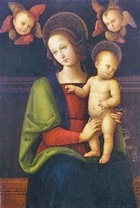
Gonfalon of the Madonna della Giustizia (1496)
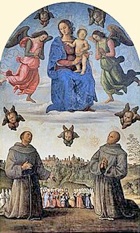
The usual name given to the work derives from the fact that it was, for a period, confused with a second banner (now lost) that the Confraternita di Sant’ Andrea (which was also known as the Confraternita della Giustizia) commissioned in 1501.
The banner depicts the Madonna and Child on a cloud with angels, with SS Francis and Bernardino kneeling in a meadow below. St Francis commends to the Virgin a group that includes the priors and their families as well as members of the confraternity. The road behind them leads to Porta Eburnea and the buildings of Colle Landone that were subsequently demolished.
Gonfalon della Consolazione (ca. 1496-8)
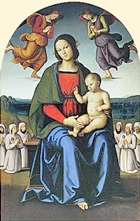
When the confraternity was suppressed in 1797, one of its members hid the banner in his home in order to avoid confiscation by the French. The confraternity re-opened and merged with the Confraternita di San Pietro Martire in 1801, and the banner was moved to the Oratorio di San Pietro Martire. It entered the Galleria Nazionale in 1863.
The banner, which has been recently restored, depicts the Madonna and Child seated in a rural landscape and flanked by a pair of praying angels, with members of the confraternity kneeling to the sides.
Ranieri Annunciation (ca. 1496)
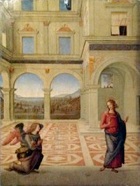
St Francis and Penitents (1499)
The archives of the Confraternita di San Francesco record a series of payments to Perugino for “uno drappellone”, which was almost certainly this image on silk from the Oratorio di San Francesco. A modest work like this is likely to have been a workshop production, a hypothesis supported by the fact that one of the payments was made into the hands of the young apprentice, Giovanni Francesco Ciambella (il Fantasia). It was transferred to the Galleria Nazionale in the mid-19th century
The drape portrays the standing St Francis with four kneeling penitents behind him, against a backdrop of golden silk brocade. The saint holds a cross and a closed book, and all of his stigmata are visible.
Tezi Altarpiece (1500)
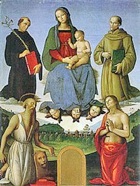
The altarpiece was specified as the exemplar for an altarpiece that Bartolomeo di Lorenzo commissioned from Eusebio di San Giorgio for Sant’ Agostino in 1506. Perugino’s altarpiece remained in its original location until 1653, when it was moved and subsequently dismembered.
-
✴The main panel, which depicts the Madonna and Child with SS Nicholas of Tolentino and Bernardino, remained in the church until 1863, when it was transferred to the Galleria Nazionale.
-
✴The predella, which depicts the Last Supper, seems to have been a workshop production. It was probably stolen during the French occupation of Perugia in 1797. It turned up in a private collection in Frankfurt in 1833, when it was sold to the Staatliche Museen, Berlin. It is illustrated in this page from Wikipedia.
Holy Family with St Anne (1502)
Angelo di Tommaso Conti commissioned this altarpiece, which is signed by Perugino and dated, for the Cappella di Sant' Anna in Santa Maria degli Angeli (or dei Fossi). It is unusual in the number of members of the holy family, both adult and infant, that are included in the composition.
It was moved to the Ospedale di Santa Maria della Misericordia in 1789. Napoleon's commissioner, Jacques-Pierre Tinet selected it for confiscation in 1797, and it was sent from Paris to Marseilles in 1801. It is now in the Musée des Beaux Arts, Marseilles and illustrated in the Web Gallery of Art.
Sant' Agostino Polyptych (1502-23)
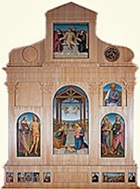
Perugino was commissioned in 1502 to paint some 30 panels for the polyptych. Progress was slow and the friars resorted to litigation, before renewing Perugino’s contract in 1512. They returned to the fray again in 1520, pressing Perugino to complete his work by 1521. It must have been largely complete by the time of his death in 1523 because his executors requested final payment. (As part of this final payment, the friars promised to move Perugino’s body from the Oratorio dell’ Annunziata, Fontignano to Sant’ Agostino, but this promise was never honoured.)
The altarpiece was dismantled in 1654 and its panels were displayed in various locations in the church. They were moved to a store room when the church was restored in 1794. Napoleon's commissioner, Jacques-Pierre Tinet selected seven of them for confiscation in 1797, and they were subsequently dispersed (see below). The remainder were moved to the Galleria Nazionale in 1863.
-
✴The restoration of the panels in the gallery in 1997 allowed their original locations within the frame and the sequence in which they were painted to be established.
-
✴The twelve panels in the double-sided predella were integral to the structure of the frame, and they were probably in place by 1512. Since Perugino had been away from Perugia for most of the period 1502-12, these panels were probably largely the work of his workshop.
-
✴The panels that formed the central register of the side of the altarpiece facing the nave seem to have been installed soon after 1512.
-
✴The panels that formed the central register of the side of the altarpiece facing the friars’ choir seem to have been painted and installed over an extended period that probably culminated in ca. 1520.
-
✴The last substantial panels to be painted seem to have been those of the two upper registers.
The probable reconstruction is illustrated in this page in Wikipedia.
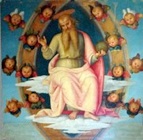
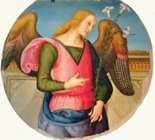
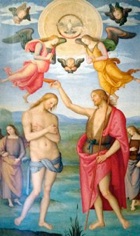
-
✴God the Father (in the top register, exhibited here, illustrated above);
-
✴SS Philip and Augustine (now in the Musée des Augustins, Toulouse), with the Archangel Gabriel (exhibited here, illustrated above);
-
✴the Baptism of Christ (the main panel, exhibited here, illustrated to the right); and
-
✴SS Herculanus and James (now in the Musée des Beaux Arts, Lyon).
A panel of the Virgin Annunciate that was the pendant to the Archangel Gabriel was among those taken to France in 1797, but was subsequently lost.
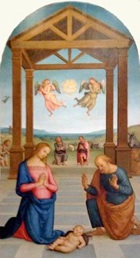
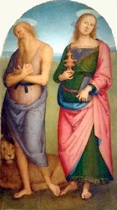
The main panels from the side of the polyptych facing the friars were:
-
✴the Pietà with the Virgin, St John the Evangelist and Joseph of Arimathea (taken to France in 1797 and returned to Perugia in 1816, when it was given to the monks of San Pietro);
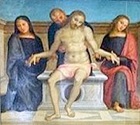
-
-
-
-
✴SS Sebastian and Irene (now in the Musée des Beaux Arts, Grenoble), with a young saint (possibly St Martin of Tours) with a sword above (now in the Musée du Louvre, Paris) ;
-
✴the Adoration of the Shepherds (the main panel, exhibited here, illustrated above); and
-
✴SS Mary Magdalene and Jerome (exhibited here, illustrated above), with St Bartholomew above (now in the Museum of Art, Birmingham, Alabama).
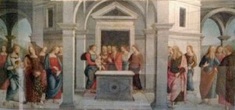
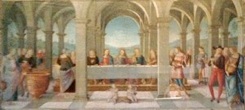
The twelve predella panels are now in the gallery, although only two are displayed. They depict:
-
✴the presentation of Jesus at the Temple; and
-
✴the wedding at Cana.
Monteripido Altarpiece (1502)
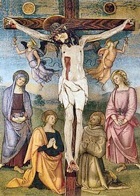
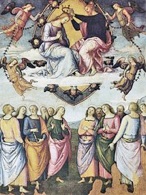
In 1502, the friars of the Convento di Monteripido used money that had been left to them in a will some five decades earlier to commission this double-sided altarpiece from Perugino.
-
✴On the side facing the friars in the choir, mourning figures of the Virgin, SS Mary Magdalene, John the Evangelist and Francis and angels were painted to form the backdrop to the polychrome wooden Crucifix (ca. 1460) attributed to Giovanni Tedesco that already decorated the high altar.
-
✴On the side facing the congregation, the Apostles witness the Coronation of the Virgin, which takes place in a mandorla supported by angels. (The friars specified the enthroned Christ and the Virgin with four saints below: the final composition reflected that of the Coronation of the Virgin (1486) that Domenico Ghirlandaio had painted for the high altar of the church of another Observant Franciscan convent, San Girolamo, Narni.
-
✴There was also a predella, subsequently lost, that included representations of SS Bernardino da Siena and Bernardino da Feltre.
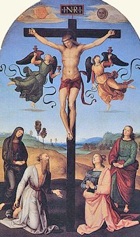
Agostino Tofanelli selected the altarpiece for the Musei Capitolini, Rome in 1812. It was returned to Perugia in 1817 and ceremonially translated to its original position on the high altar in 1822. It entered the Galleria Nazionale in 1863 and was restored in 1994.
Adoration of the Shepherds (ca. 1504)
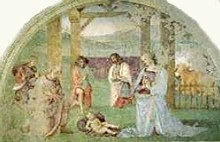
The Ercolani family probably commissioned the three frescoes that were recorded in the lunettes in walls of the Cappella della Natività, in the first cloister of the Convento di Monteripido. These frescoes, which were attributed to Perugino, depicted:
-
✴the announcement to the shepherds of the birth of Christ;
-
✴the Adoration of the Shepherds (above the altar); and
-
✴the Adoration of the Magi.
The frescoes were recorded in 1674, by which time they were badly damaged. Those on the side walls were subsequently lost. The fresco of the Adoration of the Shepherds was detached in 1856 and is now in the Galleria Nazionale. It was restored as far as possible in 1994.
In this fresco, the baby Jesus lies on the ground, adored by the Virgin and St Joseph and four kneeling shepherds. The composition of this surviving fresco is related to two other frescoes of this subject:
-
✴the fresco (1496-1500) in the Collegio del Cambio; and
-
✴the fresco (1503) in San Francesco, Montefalco.
It was probably painted shortly afterwards.
St John the Baptist Altarpiece (ca 1510)
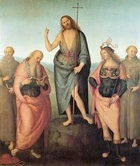
The panel depicts St John the Baptist standing in a landscape, flanked by SS Francis, Jerome, Sebastian and Antony of Padua. The figure of St Sebastian is curiously dressed and has been adapted, somewhat opportunistically, from a cartoon used in Perugino's frescoes (ca. 1500) in the Collegio di Cambio. Two other stylistic considerations provide circumstantial evidence for the dating to ca. 1510:
-
✴The composition, and in particular the figures of SS Francis and Jerome seem to derive from the Madonna di Loreto (1507), which Perugino painted for Santa Maria dei Servi and which is now in the National Gallery, London (see below).
-
✴Mariano de Ser Austerio used the figure of St John the Baptist in the altar frontal (1512) that he painted for the Cappella di San Giovanni Battista of the Collegio di Cambio.
Madonna della Cucina (ca. 1515)
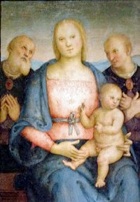
Transfiguration (1517)
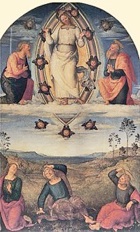
-
✴The main panel is based on the fresco (1496-1500) of the Transfiguration that Perugino had painted in the Collegio del Cambio, with the addition of a rural landscape and a mandorla of seraphim around the transfigured Christ.



-
✴Three small panels that also came from Santa Maria Nuova in 1863, which are separately exhibited in the gallery, seem to have belonged to the predella of this altarpiece. They depict:
-
•the Annunciation;
-
•the Nativity; and
-
•the Baptism of Christ.
-
It is possible that there were originally one or two others that have been lost.
Martyrdom of St Sebastian (1518)
Giuliano and Sinibaldo Martinello commissioned this altarpiece from Perugino in 1505 for their chapel in San Francesco al Prato. It was not completed until 1518, the date inscribed on the base of the column to which the saint is tied, and Perugino was forced to litigate in 1520 to obtain the final payment. The altarpiece was moved from its original location at some time in the 16th century, and subsequently suffered serious damage. It therefore escaped requisition by the French, and was transferred to the Galleria Nazionale in 1863.
The panel depicts the saint tied to a column in an architectural setting. Two archers take aim, while two flying angels witness the scene. The composition is a reduced version of the fresco (1505) that Perugino executed for the church of San Sebastiano, Panicale.
St Jerome (16th century)
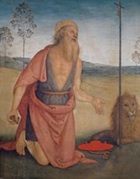
St Jerome is depicted as a hermit, kneeling in contemplation of a Crucifix, with a stone in his hand and his lion and cardinal’s hat on the ground nearby. The figure is set in a rural landscape.
Blessed James of the Marche (16th century)
This banner, which is attributed to Perugino, came from the Oratorio dei SS Girolamo, Francesco e Bernardino. It depicts the Blessed James of the Marche holding a reliquary of the Blood of Christ. It belonged to a confraternity that the Blessed James had founded in 1445. It was noted in an inventory of the possessions of the confraternity in 1532, but not in an earlier one from 1517, suggesting that it was commissioned thereafter. The oratory was demolished in 1797, at which point the banner was moved into the adjacent church. It was moved to the Accademia di Belle Arte in 1810 and is now in the Galleria Nazionale.
Other Works in Perugia
Collegio del Cambio
Frescoes (1496-1500)
The extensive fresco cycle in the Sala dell’ Udienza of the Collegio di Cambio is the masterpiece of Perugino. According to Giorgio Vasari, his main assistant was Andrea d’ Assisi, l' Ingegno.
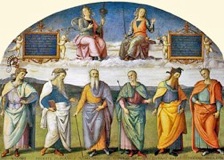
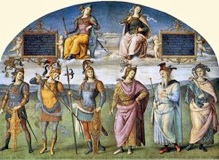
The side walls contain frescoes of allegories of civic virtues using humanist iconography that seems to have been the work of Francesco Maturanzio, the secretary to the Priori delle Arti.
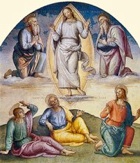
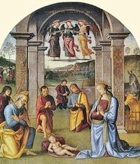
The back wall contains two more conventional scenes:
-
✴the Nativity (on the right); and
-
✴the Transfiguration (on the left).
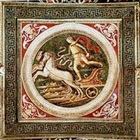
A frescoed self-portrait of Perugino (illustrated above) appears as a panel hung from the left wall. The inscription by Francesco Maturanzio praises the artist: "If the art of painting was lost, he rediscovered it. If it was not yet invented, he brought it to this point".
San Pietro Polyptych (1495-1500)
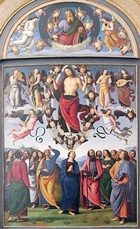
The altarpiece was removed and dismantled in 1608, during the re-modelling of the church. From this time, the main panel of the Ascension was hung in the apse, and the other panels were distributed within the church. The probable reconstruction of the original disposition is illustrated in this page in Wikipedia.
Napoleon's commissioner, Jacques-Pierre Tinet selected most of the panels (except five predella panels of saints that escaped his attention) for confiscation in 1797, and they were sent to Paris. They were subsequently dispersed:
-
✴The main panel of the Ascension of Christ was sent to Lyon in 1811 and is now in the Musée des Beaux Arts, Lyon.
-
✴The lunette of God the Father with angels was installed in the Parisian church of St Gervais in 1811. It was reunited with the main panel in the Musée des Beaux Arts, Lyon in 1952.
-
✴Tondi of the prophets David and Isaiah, which possibly came from protective doors that covered the altarpiece, were sent to Nantes in 1809 and are now in the Musée des Beaux Arts, Nantes.
-
✴The predella panels of the Adoration of the Magi, the Baptism of Christ and the Resurrection were sent to Rouen in 1803 and are now in the Musée des Beaux Arts, Rouen).
-
✴Antonio Canova recovered the predella panels of SS Benedict, Placidus and Justina (the patron saint of the Cassinese Congregation) in 1815, when they were secured for the Pinacoteca Vaticana, Rome.

Predella panels of SS Scholastica (the sister of St Benedict); Herculanus; Peter Abbot (the founder of San Pietro); Constantius; and Maurus remained in San Pietro until 1811, when Agostino Tofanelli secured them for the Musei Capitolini, Rome. They were returned to Perugia in 1815 and are now in the sacristy.
San Severo
Trinity with saints (ca. 1505-24)
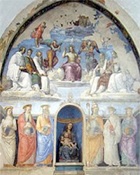
Upper Part (ca. 1505)
According to an inscription to the left of this fresco, Raphael painted the upper part in 1505, in the time of the Prior Ottaviano di Stefano da Volterra. Some authorities query this early date, given the mature style of the fresco, but others see no reason to dispute it. This was the only fresco commission that Raphael ever won in Perugia, and it is the only certain work of his that is left in the city. It was incomplete when he left the city for Rome, but the monks did not give up hope of further progress until he died there in 1520.
This upper part of the fresco depicts the Trinity (although the figure of God the Father is ruined) and angels, with six saints that are identified by inscriptions:
-
✴SS Maurus, Placidus and Benedict on the left; and
-
✴SS Romuald, Benedict Martyr and John the Monk on the right.
(The last two were Camaldolesian monks from Benevento who were martyred in Poland in 1005 and whose cult was confirmed in 1508).
Lower Part (1521)
After the death of Raphael, the monks turned to the aged Perugino to complete the work. The inscription to the right records that he executed the saints to the sides of the niche in 1521, in the time of the Prior Silvestro di Stefano da Volterra. Again, these saints are identified by inscription:
-
✴SS Scholastica, Jerome and John the Evangelist on the left; and
-
✴SS Gregory the Great, Boniface and Martha on the right.
(St Boniface was a Camaldolesian monk and relative of the Emperor Otto III who was martyred in Poland in 1009).
Madonna delle Grazie (ca. 1515)
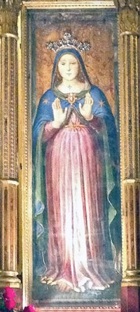
This panel has traditionally been attributed to Giannicola di Paolo, [but it has been more recently attributed to Perugino ??].
Madonna delle Grazie (1522)
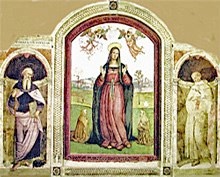
This fresco is on a wall in what is now the Cappella della Consolazione of the nunnery of Sant’ Agnese. The nuns have always venerated it because they believe that it protects their community. It is in the form of a frescoed triptych, with the orant Virgin with two kneeling nuns in a landscape, flanked by SS Antony Abbot and Antony of Padua. Its recent restoration has confirmed its attribution to the aged Perugino.
This restoration recovered the original inscription, which gave both the date and the names of the donors: Eufrasia degli Arcipreti and Teodora di Pier Matteo (presumably the nuns who kneel on either side of the Virgin). It also established that the fresco remains on the wall on which it was originally painted (contradicting earlier theories that it had been detached from its original location and moved here). The wall in question seems to have been open to the elements in the nuns' cloister until the construction of the chapel.
Works from Perugia
As noted above, most of the panels of the San Pietro Polyptych (1495-1500) have been dispersed. Other works by Perugino in Perugia that are now elsewhere are described below.
Resurrection of Christ (1499)
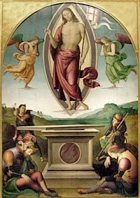
Marriage of the Virgin (1499-1504)
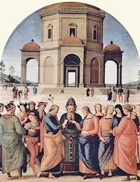
Napoleon's commissioner, Jacques-Pierre Tinet selected the altarpiece for confiscation in 1797, and it was duly sent to Paris. It was transferred to Caen in 1804 and is now in the Musée des Beaux Arts, Caen.
Perugino seems to have based this composition on that of his fresco (ca. 1480) of Christ giving the keys of Heaven to St Peter in the Sistine Chapel, Rome (see below). The marriage takes place in front of the Temple. St Joseph holds the rod that flowered in order to identify him as the bridegroom selected by God: the other suitors stand behind him, and one of them breaks his own rod because it failed to flower.
Raphael’s Marriage of the Virgin (1504), which was painted for the Altare di San Giuseppe in San Francesco, Città di Castello, was closely modelled on Perugino’s altarpiece in Perugia.
Capra Altarpiece (ca. 1505)
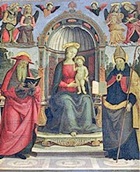
The most obvious interpretation was that Filippo di Benedetto had commissioned the altarpiece in memory of his father, the jurist Benedetto Capra, who had been granted a chapel in Sant’ Agostino in 1469 and who had died in 1470. However, this caused scholars some consternation, since the altarpiece is dated on stylistic grounds to ca. 1505. However, the confusion seems to have been caused by the fact that:
-
✴Filippo’s son was also called Benedetto; and
-
✴his son (i.e. the jurist’s great grandson) was also called Filippo.
It must have been this second Filippo di Benedetto who commissioned the altarpiece. Pietro Scarpellini attributed the work largely to Giovanni Battista Caporali (as referenced in the page on this artist), albeit that “Pietro [Perugino] intervened at the last moment to put his imprint on a work that came from his workshop” (my translation).
The altarpiece remained in its original location until 1653 and was then moved to other locations in the church. It was removed to the convent in 1794 before the start of the re-modelling of the church. Napoleon's commissioner, Jacques-Pierre Tinet selected it for confiscation in 1797:
-
✴The main panel, which depicts the Madonna and Child with SS Jerome and Augustine, was sent from Paris to Bordeaux in 1803. It is now in the Musée des Beaux-Arts, Bordeaux.
-
✴Two predella panels depicting miracles of St Nicholas of Tolentino, which might have belonged to this altarpiece or alternatively to that of the Coronation of St Nicholas of Tolentino by Raphael, found their way into the collection of Ralph Harman Booth (died 1931). His widow gave them to the Institute of Arts, Detroit, and they are illustrated in the institute's website.
Madonna di Loreto (1507)
In 1507, Giovanni di Matteo di Giorgio Schiavone, a carpenter who had rented a workshop from the friars of Santa Maria dei Servi, left money for the endowment of a new chapel in the church that became known as the Cappella Schiavone. He also bequeathed money for an altarpiece, and the friars, who were named as his executors, almost immediately commissioned Perugino to paint it. (The artist charged an unusually low price, suggesting that he may have had a professional relationship with the deceased carpenter).
The original frame was recently discovered in the deposit of the Galleria Nazionale, confirming that the altarpiece only ever comprised this single panel. It depicts the standing Virgin and SS Jerome and Francis. It was moved to Santa Maria Nuova in 1540, when it was placed on an altar that subsequently belonged to the della Penna family.
Fabrizio della Penna bought the altarpiece from the friars in 1821 for his private collection, and included a copy by Giuseppe Carattoli that replaced it on the altar as part of the price. He sold the original to the National Gallery, London in 1879. The copy remains in situ in Santa Maria Nuova.
Assisi
Frescoes (1477)
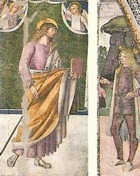
-
✴St James (on the left); and
-
✴St Ansanus (on the far right);
are attributed to Andrea d' Assisi, l' Ingegno or (more recently) to Perugino.
Crucifixion (ca. 1486)
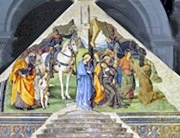
In 1486, shortly after the friars had built a choir against the apse of the Portiuncula, Antonia di Simone left money in her will for the decoration of its external wall. In his life of Perugino, Giorgio Vasari wrote that, at Santa Maria degli Angeli, the artist had painted “in fresco, a Christ on the Cross, with many figures, on the wall at the back of the Chapel of the Madonna [i.e. the Cappella della Portiuncula], which faces the choir of the monks”. He also said that Andrea d’ Assisi, l' Ingegno had participated in Perugino’s work in Assisi, by which he presumably meant in this commission
Vasari wrote his account in 1568, just a year before the choir was demolished. The frescoes were plastered over shortly after, when the choir chapel was demolished to make way for the present church. They were rediscovered early in the 19th century and heavily repainted.
The lower half of the fresco of the Crucifixion survives in situ, although the upper part was destroyed when the choir was demolished. It was restored in 1998, when some of the damage inflicted by the repainting of the 19th century was reversed, and Vasari’s attribution of the work to Perugino was confirmed. The surviving part depicts the leg of Christ on the Cross, with St Francis and a group of women, including the swooning Madonna, to the right. To the left, a young boy leads two Pharisees to the scene and one of two mounted soldiers draws their attention to the Crucified Christ.
Figures of the Annunciation (ca. 1486)
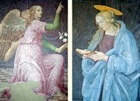
These detached frescoes were painted on the curved exterior wall of the apse of the Cappella della Portiuncula. Like the Crucifixion that remains in situ there (see above), they are attributed to Perugino (or to his workshop). They were plastered over in the 16th century and re-discovered in the early 19th century. The artist Antonio Castelletti is documented as restoring the frescoes of the “Cappella dell’ Annunziata” in 1828, and this seems to have involved the effective repainting of these frescoes. They were detached in 1975 and are now in the Museo della Portiuncula.
Bettona
Altarpieces from Sant’ Antonio da Padova (ca. 1512)
These two altarpieces from the Convento di Sant’ Antonio da Padova are now in the Pinacoteca Civica.
-
✴This altarpiece depicting St Antony of Padua is signed by Perugino. The inscription also records that it was commissioned by Bartolomeo di Maraglia, who was taken prisoner by the French at the the Battle of Marignano in 1512 (when in the pay of Gian Paolo Baglioni). Bartolomeo di Maraglia is depicted in armour kneeling at the feet of the saint giving thanks for his release.
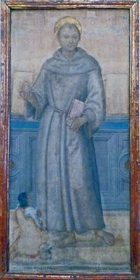
-
✴This altarpiece of the Madonna della Misericordia with saints is attributed to Perugino. It depicts the Madonna della Misericordia sheltering SS Stephen and Jerome and two kneeling donors (presumably a married couple).
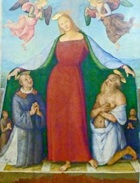
Foligno
Baptism of Christ (1507)
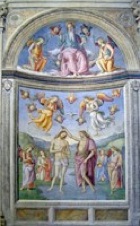
The main scene of the baptism of Christ is set in a landscape and witnessed by angels. God the Father looks down on the scene from the lunette above.
Montefalco
Frescoed altarpiece (1503)
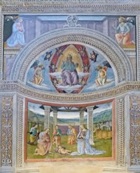
Orvieto
Frescoes of the Cappella Nuova (1489-91)
On November 1489, the Opera del Duomo resolved to complete the decoration of the the Cappella Nuova, since the forty years’ hiatus that had occurred since the project had been started was “a great disgrace” for them. Some six weeks later, “master Pietro Perugino, a painter famous throughout Italy”, who was then in Orvieto to discuss the project, was appointed to complete the vaults.
However, despite a series of pleas from the Opera del Duomo, Perugino proved elusive, except for short visits to Orvieto in March/April and September/October 1491. The relevant documents for the latter visit include a reference to “Andreas alias Ingegnio, famulus ... magistri Petri” ((Andrea d’ Assisi, l’ Ingegno, apprentice of Perugino). A fresco of St Michael from the Cappellina di Santa Maria Maddalena, which no longer survives but which is known from photographs, is sometimes attributed to him.
The Opera del Duomo sent a letter to him in 1492, threatening to appoint another artist in his stead, to which Perugino’s Roman patron Cardinal Giuliano della Rovere (the future Pope Julius II) replied in equally strident terms. (Perugino painted a polyptych for Cardinal Giuliano for SS Apostoli, Rome at this time).
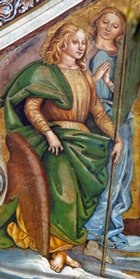
Spello
Detached frescoes (1521)
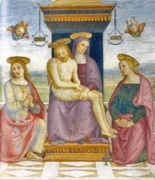
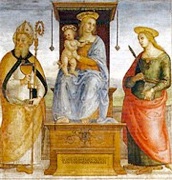
These panels were commissioned for two altars (1515) that Rocco di Tommaso da Vicenza built on the pilasters that flank the presbytery of Santa Maria Maggiore. Rocco di Tommaso first negotiated a contract for their altarpieces with Giannicola di Paolo in 1520, but this contract was never honoured. The work was then commissioned from the elderly Perugino in 1521.
The altars were destroyed in 1644, but the altar walls and their frescoes survive in their original locations. The frescoes depict:
-
✴the Madonna enthroned with the dead Christ, with SS John the Evangelist and Mary Magdalene, which is signed by Perugino (on the left); and
-
✴the Madonna and Child with SS Blaise and Catherine of Alexander.
Both works are dated by inscription and each names the donor (respectively Michelangelo Andine and Giovanni Bernadelli) in an inscription along the base of the throne.
Trevi
Frescoes (1521)
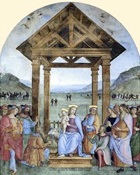
-
✴the figures of the Annunciation in tondi in the arch above; and
-
✴figures of SS Peter and Paul in painted niches to the sides.
Sistine Chapel, Rome
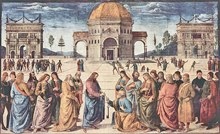
Christ giving the keys of Heaven to St Peter
Giorgio Vasari records three frescoes that Perugino painted on the altar wall of the Sistine Chapel shortly after Pope Sixtus IV had effectively rebuilt it in 1475-9:
-
✴a fictive altarpiece of the Assumption of the Virgin, in which the kneeling Sixtus IV was represented; and
-
✴presumably to the sides:
-
•the Nativity; and
-
•the finding of Moses in the bullrushes.
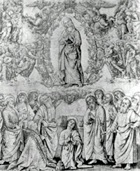
Two documents that relate to the later decoration of the chapel walls survive:
-
✴in 1481, Giovanni di Dolci (on behalf of Sixtus IV) signed a contract with Perugino and three older, Florentine artists, Sandro Botticelli, Cosimo Rosselli and Domenico Ghirlandaio, to paint ten bays of the chapel; and
-
✴in 1482, payment was agreed with the same four artists for the decoration of four bays (presumably one each) that had been completed.
Although this documentation does not specify who did what, and in what order, the most likely sequence is that:
-
✴the decoration of the four bays that were complete by 1482 had begun after the completion of Perugino’s altar wall; and
-
✴that work began on the last ten bays of the chapel following the contract of 1481.
Two of these last ten frescoes, which were on the entrance wall, were destroyed in 1522 when the lintel over the door collapsed, and they were subsequently repainted.
Of the twelve surviving frescoes (six scenes from the life of Christ on the right and six scenes from the life of Moses on the left), four are generally attributed to Perugino and his associates:
-
✴the Baptism of Christ, which is signed by Perugino and contains his self-portrait, and which was probably his completed work in the contract of 1482;
-
✴Christ giving the keys of Heaven to St Peter (illustrated above); and
The last two of these probably involved the use of assistants:
-
✴According to Vasari, the Florentine Rocco Zoppo painted two of the figures of early popes in the frieze above the narrative frescoes. He is documented in Perugino’s Florentine workshop in 1496-1501; some frescoes in San Girolamo, Spello are attributed to him; and he is said to have died in 1508.
-
✴Vasari recorded that Pintoricchio worked with Perugino in Rome at the time of Sixtus IV, and it entirely possible that this collaboration included the work in the Sistine Chapel.
-
✴Vasari claimed that claimed that Sixtus IV called Luca Signorelli to Rome to work on the project “in competition with many other painters” and that he painted two of the best scenes:
-
•Moses declaring his Testament to the people of Israel; and
-
•the death of Moses, by which he probably meant one of the now-lost frescoes on the entrance wall.
-
It is likely that Signorelli did work with Perugino towards the end of the project, and possible that he took over the project when the other artists left:
-
•his extensive participation has been detected in the Testament of Moses; and
-
•he may have contributed figures in the scene of Christ giving the keys of Heaven to St Peter.
Read more:
The literature on Perugino is extensive. Much of it was referenced in the catalogue of the important exhibition that was held in Perugia in 2004:
V. Garibaldi and F. F. Mancini, “Perugino: il Divin Pittore”, (2004) Milan
Return to Art in: Assisi Bettona Foligno Montefalco Orvieto Perugia Spello Trevi.

